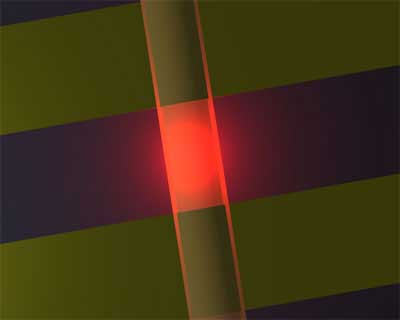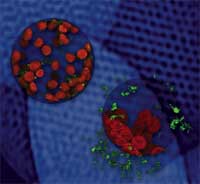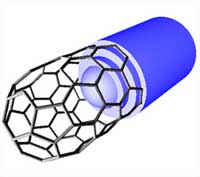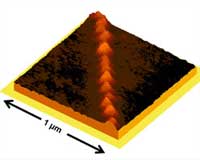Showing Spotlights 2473 - 2480 of 2786 in category All (newest first):
 Nanofluidic channels, confining and transporting tiny amounts of fluid, are the pipelines that make the cellular activities of organisms possible. For instance, nanoscale channels carry nutrients into cells and waste from cells. Researchers are trying to mimic Nature by constructing nanochannels in order to be able to manipulate single molecules in, predominantly biomedical, applications. Although nanochannels adjustable in size are prevalent in Nature, it is challenging to fabricate them artificially because of conflicting requirements for rigid structural integrity (to prevent collapse) on one hand and reconfigurability of nanometer-sized features on the other (to allow adjustability). Recent work at the University of Michigan addresses these issues and introduces methods to rapidly prototype structurally stable yet reconfigurable nanochannels. By fabricating tuneable elastomeric nanochannels for nanofluidic manipulation, the researchers were able to properly balance the need for flexibility and rigidity.
Nanofluidic channels, confining and transporting tiny amounts of fluid, are the pipelines that make the cellular activities of organisms possible. For instance, nanoscale channels carry nutrients into cells and waste from cells. Researchers are trying to mimic Nature by constructing nanochannels in order to be able to manipulate single molecules in, predominantly biomedical, applications. Although nanochannels adjustable in size are prevalent in Nature, it is challenging to fabricate them artificially because of conflicting requirements for rigid structural integrity (to prevent collapse) on one hand and reconfigurability of nanometer-sized features on the other (to allow adjustability). Recent work at the University of Michigan addresses these issues and introduces methods to rapidly prototype structurally stable yet reconfigurable nanochannels. By fabricating tuneable elastomeric nanochannels for nanofluidic manipulation, the researchers were able to properly balance the need for flexibility and rigidity.
May 17th, 2007
 Over the next few years, semiconductor fabrication will move from the current state-of-the-art generation of 90 nanometer processes to the next 65 nm and 45 nm generations. Intel is even already working on 32 nm processor technology, code-named "Westmere", that is expected to hit the market sometime around 2009. The result of these efforts will be billion-transistor processors where a billion or more transistor-based circuits are integrated into a single chip. One of the increasingly difficult problems that chip designers are facing is that the high density of components packed on a chip makes interconnections increasingly difficult. In order to be able to continue the trend predicted by Moore's law, at least for a few more years, researchers are now turning to alternative materials for transistors and interconnect and one of the prime candidates for this job are single-walled carbon nanotubes (SWCNT). However, one of the biggest limitations of conventional carbon nanotube device fabrication techniques today is the inability to scale up the processes to fabricate a large number of devices on a single chip. Researchers in Germany have now demonstrated the directed and precise assembly of single-nanotube devices with an integration density of several million devices per square centimeter, using a novel aspect of nanotube dielectrophoresis. This development is a big step towards commercial realization of CNT-based electronic devices and their integration into the existing silicon-based processor technologies.
Over the next few years, semiconductor fabrication will move from the current state-of-the-art generation of 90 nanometer processes to the next 65 nm and 45 nm generations. Intel is even already working on 32 nm processor technology, code-named "Westmere", that is expected to hit the market sometime around 2009. The result of these efforts will be billion-transistor processors where a billion or more transistor-based circuits are integrated into a single chip. One of the increasingly difficult problems that chip designers are facing is that the high density of components packed on a chip makes interconnections increasingly difficult. In order to be able to continue the trend predicted by Moore's law, at least for a few more years, researchers are now turning to alternative materials for transistors and interconnect and one of the prime candidates for this job are single-walled carbon nanotubes (SWCNT). However, one of the biggest limitations of conventional carbon nanotube device fabrication techniques today is the inability to scale up the processes to fabricate a large number of devices on a single chip. Researchers in Germany have now demonstrated the directed and precise assembly of single-nanotube devices with an integration density of several million devices per square centimeter, using a novel aspect of nanotube dielectrophoresis. This development is a big step towards commercial realization of CNT-based electronic devices and their integration into the existing silicon-based processor technologies.
May 16th, 2007
 Integrating biochemical analysis with micro- and nano-oelectromechanical systems (MEMS and NEMS) has led to the development of a new class of biomedical analytical devices called lab-on-a-chip. They combine a number of biological functions (such as enzymatic reactions, antigen-antibody conjugation, and DNA probing) with proper micro- or even nanofluidic laboratory components (such as sample dilution, pumping, mixing, metering, incubation, or separation) and detection in micron- and nanometer-sized channels and reservoirs into one single device. In order to reduce the size of these lab-on-chip devices even more, researchers increasingly are finding ways to turn micron-sized components into nanosized components. One problem they have been faced with so far is the issue of illumination. Today, many state-of-the-art lab-on-a-chip devices use external illumination sources, such as lasers or light emitting diodes (LEDs). Being able to fully integrate the excitation and detection mechanisms on lab-on-a-chip devices would allow further size reductions and increase the flexibility for using and handling them. Researchers at Cornell University have electrospun light-emitting nanofibers that, if they can be integrated with micro- and nanofluidic devices, could achieve excitation of light-induced fluorescence and detection within that same device.
Integrating biochemical analysis with micro- and nano-oelectromechanical systems (MEMS and NEMS) has led to the development of a new class of biomedical analytical devices called lab-on-a-chip. They combine a number of biological functions (such as enzymatic reactions, antigen-antibody conjugation, and DNA probing) with proper micro- or even nanofluidic laboratory components (such as sample dilution, pumping, mixing, metering, incubation, or separation) and detection in micron- and nanometer-sized channels and reservoirs into one single device. In order to reduce the size of these lab-on-chip devices even more, researchers increasingly are finding ways to turn micron-sized components into nanosized components. One problem they have been faced with so far is the issue of illumination. Today, many state-of-the-art lab-on-a-chip devices use external illumination sources, such as lasers or light emitting diodes (LEDs). Being able to fully integrate the excitation and detection mechanisms on lab-on-a-chip devices would allow further size reductions and increase the flexibility for using and handling them. Researchers at Cornell University have electrospun light-emitting nanofibers that, if they can be integrated with micro- and nanofluidic devices, could achieve excitation of light-induced fluorescence and detection within that same device.
May 15th, 2007
 Most nanobiotechnology research today is focused on human medical applications and, mostly for testing and demonstration purposes, on animals. As nanotechnology is gaining interest with regard to agricultural applications, plant science research focusing on investigation of plant genomics and gene function as well as improvement of crop species has become a nanotechnology frontier. Plant cells differ from animal cells in several aspects, a major one being that they possess a wall surrounding them to provide, among other things, mechanical and structural support. The plant cell wall is generally made up of pollysacharides and cellulose. Cellulose provides a stiff and rigid environment for the cell to live in. Thanks to this wall, viruses have no active way of penetrating plant cells but rely on mechanical wounds or infected seeds for transmission. Researchers are commonly using surface-functionalized silica nanoparticles as nonviral nanocarriers for experimental drug and DNA delivery into animal cells but their use with plants so far was limited due to the cell wall. In a first demonstration of the utilization of porous nanoparticle materials for intracellular controlled release and gene transfer application in plants, researchers have used silica nanoparticles to penetrate the cell wall and deliver a payload into the cell.
Most nanobiotechnology research today is focused on human medical applications and, mostly for testing and demonstration purposes, on animals. As nanotechnology is gaining interest with regard to agricultural applications, plant science research focusing on investigation of plant genomics and gene function as well as improvement of crop species has become a nanotechnology frontier. Plant cells differ from animal cells in several aspects, a major one being that they possess a wall surrounding them to provide, among other things, mechanical and structural support. The plant cell wall is generally made up of pollysacharides and cellulose. Cellulose provides a stiff and rigid environment for the cell to live in. Thanks to this wall, viruses have no active way of penetrating plant cells but rely on mechanical wounds or infected seeds for transmission. Researchers are commonly using surface-functionalized silica nanoparticles as nonviral nanocarriers for experimental drug and DNA delivery into animal cells but their use with plants so far was limited due to the cell wall. In a first demonstration of the utilization of porous nanoparticle materials for intracellular controlled release and gene transfer application in plants, researchers have used silica nanoparticles to penetrate the cell wall and deliver a payload into the cell.
May 14th, 2007
 The Oklahoma land rush of 1889 and similar land runs were events in which previously restricted land of the United States was opened for homesteading on a first come, first claim basis. A number of the individuals who participated in the run entered early and hid out until the legal time of entry to lay quick claim to some of the most choice homesteads. These people came to be identified as "sooners" and their actions led to hundreds of legal contests. Nowadays, universities and companies, from start-ups to multinational conglomerates, are rushing to aggressively stake out their turf in the nanotechnology patent area. The "sooners" in this nanotechnology patent land rush may be the ones who were issued what some say are "unduly broad" patents early on, in the hope of getting a windfall of nanotechnology intellectual property (IP) rights. While not violating the rules intentionally, upon re-examination some broad patents might not hold up to the United States Patent Act's requirement for full and complete disclosure. This uncertainty provides fertile grounds for possible litigation over nanotechnology patent claims based on broad and unprecise definitions and descriptions. Efforts are underway to address some of these problems.
The Oklahoma land rush of 1889 and similar land runs were events in which previously restricted land of the United States was opened for homesteading on a first come, first claim basis. A number of the individuals who participated in the run entered early and hid out until the legal time of entry to lay quick claim to some of the most choice homesteads. These people came to be identified as "sooners" and their actions led to hundreds of legal contests. Nowadays, universities and companies, from start-ups to multinational conglomerates, are rushing to aggressively stake out their turf in the nanotechnology patent area. The "sooners" in this nanotechnology patent land rush may be the ones who were issued what some say are "unduly broad" patents early on, in the hope of getting a windfall of nanotechnology intellectual property (IP) rights. While not violating the rules intentionally, upon re-examination some broad patents might not hold up to the United States Patent Act's requirement for full and complete disclosure. This uncertainty provides fertile grounds for possible litigation over nanotechnology patent claims based on broad and unprecise definitions and descriptions. Efforts are underway to address some of these problems.
May 11th, 2007
 Current production methods for carbon nanotubes (CNT) result in units with different diameter, length, chirality and electronic properties, all packed together in bundles, and often blended with some amount of amorphous carbon. The separation of nanotubes according to desired properties remains a technical challenge. Especially single-walled carbon nanotube (SWCNT) sorting is a challenge because the composition and chemical properties of SWCNTs of different types are very similar, making conventional separation techniques inefficient. In order to find ways to control nanotube diameter and chirality it would be necessary to monitor nanotube growth. Then, if one knew exactly how to grow nanotubes of different characteristics, one could control their electronic properties because, depending on the way the carbon atoms are arrange around the 'waist' of a nanotube, the electronic properties could vary from metallic to semiconducting. An international group of researchers has demonstrated a novel approach to use nanotubes as reaction cells, enabling them to monitor the birth and growth of carbon nanotubes, and taking some spectacular image of this process.
Current production methods for carbon nanotubes (CNT) result in units with different diameter, length, chirality and electronic properties, all packed together in bundles, and often blended with some amount of amorphous carbon. The separation of nanotubes according to desired properties remains a technical challenge. Especially single-walled carbon nanotube (SWCNT) sorting is a challenge because the composition and chemical properties of SWCNTs of different types are very similar, making conventional separation techniques inefficient. In order to find ways to control nanotube diameter and chirality it would be necessary to monitor nanotube growth. Then, if one knew exactly how to grow nanotubes of different characteristics, one could control their electronic properties because, depending on the way the carbon atoms are arrange around the 'waist' of a nanotube, the electronic properties could vary from metallic to semiconducting. An international group of researchers has demonstrated a novel approach to use nanotubes as reaction cells, enabling them to monitor the birth and growth of carbon nanotubes, and taking some spectacular image of this process.
May 10th, 2007
 Back in 1756, the German physicist Johann Gottlob Leidenfrost published a manuscript titled De Aquae Communis Nonnullis Qualitatibus Tractatus ("A Tract About Some Qualities of Common Water") in which he described a phenomenon in which a liquid, in near contact with a mass significantly hotter than its boiling point, produces an insulating vapor layer which keeps that liquid from boiling rapidly. This effect came to be called the "Leidenfrost Effect" and the associated temperature point the "Leidenfrost Temperature." An everyday example of this can be seen in your own kitchen: sprinkle a drop of water in a hot skillet - if the skillet's temperature is at or above the Leidenfrost Temperature, the water skitters across the metal and takes longer to evaporate than it would in a skillet that is hot, but at a temperature below the Leidenfrost point. Researchers in Germany have used this effect for a novel, template-free synthesis and patterning method of nanostructures.
Back in 1756, the German physicist Johann Gottlob Leidenfrost published a manuscript titled De Aquae Communis Nonnullis Qualitatibus Tractatus ("A Tract About Some Qualities of Common Water") in which he described a phenomenon in which a liquid, in near contact with a mass significantly hotter than its boiling point, produces an insulating vapor layer which keeps that liquid from boiling rapidly. This effect came to be called the "Leidenfrost Effect" and the associated temperature point the "Leidenfrost Temperature." An everyday example of this can be seen in your own kitchen: sprinkle a drop of water in a hot skillet - if the skillet's temperature is at or above the Leidenfrost Temperature, the water skitters across the metal and takes longer to evaporate than it would in a skillet that is hot, but at a temperature below the Leidenfrost point. Researchers in Germany have used this effect for a novel, template-free synthesis and patterning method of nanostructures.
May 9th, 2007
 Having written in this space about the (possibly) good and the (possibly) bad of food nanotechnology before, here is now a scientific approach to assessing how the public perceives nanotechnology in food and food packaging. Swiss social psychologist Michael Siegrist has looked into the issues of trust, risk and the public acceptance of nanotechnology before. Now, he and his colleagues have taken the area of nanofoods and tried to understand what factors influence the willingness to buy food that has been produced, processed or packaged with nanotechnology. Their conclusion: Perceived benefits seems to be the most important predictor for willingness to buy.
Having written in this space about the (possibly) good and the (possibly) bad of food nanotechnology before, here is now a scientific approach to assessing how the public perceives nanotechnology in food and food packaging. Swiss social psychologist Michael Siegrist has looked into the issues of trust, risk and the public acceptance of nanotechnology before. Now, he and his colleagues have taken the area of nanofoods and tried to understand what factors influence the willingness to buy food that has been produced, processed or packaged with nanotechnology. Their conclusion: Perceived benefits seems to be the most important predictor for willingness to buy.
May 8th, 2007
 Nanofluidic channels, confining and transporting tiny amounts of fluid, are the pipelines that make the cellular activities of organisms possible. For instance, nanoscale channels carry nutrients into cells and waste from cells. Researchers are trying to mimic Nature by constructing nanochannels in order to be able to manipulate single molecules in, predominantly biomedical, applications. Although nanochannels adjustable in size are prevalent in Nature, it is challenging to fabricate them artificially because of conflicting requirements for rigid structural integrity (to prevent collapse) on one hand and reconfigurability of nanometer-sized features on the other (to allow adjustability). Recent work at the University of Michigan addresses these issues and introduces methods to rapidly prototype structurally stable yet reconfigurable nanochannels. By fabricating tuneable elastomeric nanochannels for nanofluidic manipulation, the researchers were able to properly balance the need for flexibility and rigidity.
Nanofluidic channels, confining and transporting tiny amounts of fluid, are the pipelines that make the cellular activities of organisms possible. For instance, nanoscale channels carry nutrients into cells and waste from cells. Researchers are trying to mimic Nature by constructing nanochannels in order to be able to manipulate single molecules in, predominantly biomedical, applications. Although nanochannels adjustable in size are prevalent in Nature, it is challenging to fabricate them artificially because of conflicting requirements for rigid structural integrity (to prevent collapse) on one hand and reconfigurability of nanometer-sized features on the other (to allow adjustability). Recent work at the University of Michigan addresses these issues and introduces methods to rapidly prototype structurally stable yet reconfigurable nanochannels. By fabricating tuneable elastomeric nanochannels for nanofluidic manipulation, the researchers were able to properly balance the need for flexibility and rigidity.
 Subscribe to our Nanotechnology Spotlight feed
Subscribe to our Nanotechnology Spotlight feed





